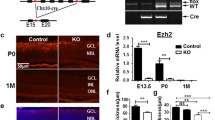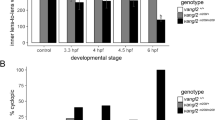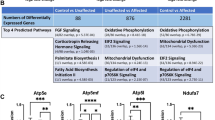Abstract
Fetal Alcohol Syndrome (FAS) affects a significant proportion, exceeding 90%, of afflicted children, leading to severe ocular aberrations such as microphthalmia and optic nerve hypoplasia. During the early stages of pregnancy, the commencement of neural retina neurogenesis represents a critical period for human eye development, concurrently exposing the developing retinal structures to the highest risk of prenatal ethanol exposure due to a lack of awareness. Despite the paramount importance of this period, the precise influence and underlying mechanisms of short-term ethanol exposure on the developmental process of the human neural retina have remained largely elusive. In this study, we utilize the human embryonic stem cells derived retinal organoids (hROs) to recapitulate the initial retinal neurogenesis and find that 1% (v/v) ethanol slows the growth of hROs by inducing robust cell death and retinal ganglion cell differentiation defect. Bulk RNA-seq analysis and two-photon microscope live calcium imaging reveal altered calcium signaling dynamics derived from ethanol-induced down-regulation of RYR1 and CACNA1S. Moreover, the calcium-binding protein RET, one of the downstream effector genes of the calcium signaling pathway, synergistically integrates ethanol and calcium signals to abort neuron differentiation and cause cell death. To sum up, our study illustrates the effect and molecular mechanism of ethanol on the initial neurogenesis of the human embryonic neural retina, providing a novel interpretation of the ocular phenotype of FAS and potentially informing preventative measures for susceptible populations.
Graphical Abstract








Similar content being viewed by others
Data Availability
The datasets generated during and/or analyzed during the current study are available from the corresponding author on reasonable request.
References
Mattson, S. N., Bernes, G. A., & Doyle, L. R. (2019). Fetal alcohol spectrum disorders: A review of the neurobehavioral deficits associated with prenatal alcohol exposure. Alcoholism, Clinical and Experimental Research, 43(6), 1046–1062.
Roozen, S., Peters, G. J., Kok, G., Townend, D., Nijhuis, J., & Curfs, L. (2016). Worldwide prevalence of fetal alcohol spectrum disorders: A systematic literature review including meta-analysis. Alcoholism, Clinical and Experimental Research, 40(1), 18–32.
Abdelrahman, A., & Conn, R. (2009). Eye abnormalities in fetal alcohol syndrome. The Ulster Medical Journal, 78(3), 164–165.
Ethen, M. K., Ramadhani, T. A., Scheuerle, A. E., Canfield, M. A., Wyszynski, D. F., Druschel, C. M., et al. (2009). Alcohol consumption by women before and during pregnancy. Maternal and Child Health Journal, 13(2), 274–285.
Centanin, L., & Wittbrodt, J. (2014). Retinal neurogenesis. Development, 141(2), 241–244.
Zhang, Z., Xu, Z., Yuan, F., Jin, K., & Xiang, M. (2021). Retinal organoid technology: Where are we now? International Journal of Molecular Sciences, 22(19), 10244.
Dorgau, B., Georgiou, M., Chaudhary, A., Moya-Molina, M., Collin, J., Queen, R., et al. (2022). Human retinal organoids provide a suitable tool for toxicological investigations: A comprehensive validation using drugs and compounds affecting the retina. Stem Cells Translational Medicine, 11(2), 159–177.
Kang, J., Gong, J., Yang, C., Lin, X., Yan, L., Gong, Y., et al. (2023). Application of human stem cell derived retinal organoids in the exploration of the mechanisms of early retinal development. Stem Cell Reviews and Reports, 19(6), 1755–1772.
Li, M., Gong, J., Gao, L., Zou, T., Kang, J., & Xu, H. (2022). Advanced human developmental toxicity and teratogenicity assessment using human organoid models. Ecotoxicology and Environmental Safety, 235, 113429.
Horejs, C. (2021). Organ chips, organoids and the animal testing conundrum. Nature Reviews Materials, 6(5), 372–373.
Toth, A. B., Shum, A. K., & Prakriya, M. (2016). Regulation of neurogenesis by calcium signaling. Cell Calcium, 59(2–3), 124–134.
Kim, J. W., Oh, H. A., Kim, S. R., Ko, M. J., Seung, H., Lee, S. H., et al. (2020). Epigenetically upregulated T-Type calcium channels contribute to abnormal proliferation of embryonic neural progenitor cells exposed to valproic acid. Biomolecules & Therapeutics (Seoul), 28(5), 389–396.
Paladino, O., Moranda, A., & Falugi, C. (2022). Spatiotemporal role of muscarinic signaling in early chick development: Exposure to cholinomimetic agents by a mathematical model. Cell Biology and Toxicology. https://doi.org/10.1007/s10565-022-09770-w
Sison, S. L., O'Brien, B. S., Johnson, A. J., Seminary, E. R., Terhune, S. S., & Ebert, A. D. (2019). Human cytomegalovirus disruption of calcium signaling in neural progenitor cells and organoids. Journal of Virology, 93(17), e00954–19.
Bootman, M. D., & Bultynck, G. (2020). Fundamentals of cellular calcium signaling: A Primer. Cold Spring Harbor Perspectives in Biology, 12(1), a038802.
Shim, S., Goyal, R., Panoutsopoulos, A. A., Balashova, O. A., Lee, D., & Borodinsky, L. N. (2023). Calcium dynamics at the neural cell primary cilium regulate Hedgehog signaling-dependent neurogenesis in the embryonic neural tube. Proceedings of the National Academy of Sciences of the United States of America, 120(23), e2220037120.
Latoszek, E., & Czeredys, M. (2021). molecular components of store-operated calcium channels in the regulation of neural stem cell physiology, neurogenesis, and the pathology of Huntington’s disease. Frontiers in Cell and Developmental Biology, 9, 657337.
Brennan, D., & Giles, S. (2013). Sonic hedgehog expression is disrupted following in ovo ethanol exposure during early chick eye development. Reproductive Toxicology (Elmsford, NY), 41, 49–56.
Kahn, B. M., Corman, T. S., Lovelace, K., Hong, M., Krauss, R. S., & Epstein, D. J. (2017). Prenatal ethanol exposure in mice phenocopies Cdon mutation by impeding Shh function in the etiology of optic nerve hypoplasia. Disease Models & Mechanisms, 10(1), 29–37.
Becker, D. L., Webb, K. F., Thrasivoulou, C., Lin, C. C., Nadershahi, R., Tsakiri, N., et al. (2007). Multiphoton imaging of chick retinal development in relation to gap junctional communication. Journal of Physiology, 585(Pt 3), 711–719.
Voufo, C., Chen, A. Q., Smith, B. E., Yan, R., Feller, M. B., & Tiriac, A. (2023). Circuit mechanisms underlying embryonic retinal waves. Elife, 12, e81983.
Sridhar, A., Hoshino, A., Finkbeiner, C. R., Chitsazan, A., Dai, L., Haugan, A. K., et al. (2020). Single-cell transcriptomic comparison of human fetal retina, hPSC-derived retinal organoids, and long-term retinal cultures. Cell Reports, 30(5), 1644–59.e4.
Kuwahara, A., Ozone, C., Nakano, T., Saito, K., Eiraku, M., & Sasai, Y. (2015). Generation of a ciliary margin-like stem cell niche from self-organizing human retinal tissue. Nature Communications, 6, 6286.
Leclerc, C., Néant, I., & Moreau, M. (2011). Early neural development in vertebrates is also a matter of calcium. Biochimie, 93(12), 2102–2111.
Chung, H. Y., Chang, C. T., Young, H. W., Hu, S. P., Tzou, W. S., & Hu, C. H. (2013). Ethanol inhibits retinal and CNS differentiation due to failure of cell cycle exit via an apoptosis-independent pathway. Neurotoxicology and Teratology, 38, 92–103.
Pan, J. B., Hu, S. C., Shi, D., Cai, M. C., Li, Y. B., Zou, Q., et al. (2013). PaGenBase: A pattern gene database for the global and dynamic understanding of gene function. PLoS ONE, 8(12), e80747.
Subramanian, A., Tamayo, P., Mootha, V. K., Mukherjee, S., Ebert, B. L., Gillette, M. A., et al. (2005). Gene set enrichment analysis: A knowledge-based approach for interpreting genome-wide expression profiles. Proceedings of the National Academy of Sciences of the United States of America, 102(43), 15545–15550.
Hodskinson, M. R., Bolner, A., Sato, K., Kamimae-Lanning, A. N., Rooijers, K., Witte, M., et al. (2020). Alcohol-derived DNA crosslinks are repaired by two distinct mechanisms. Nature, 579(7800), 603–608.
des Georges, A., Clarke, O. B., Zalk, R., Yuan, Q., Condon, K. J., Grassucci, R. A., et al. (2016). Structural basis for gating and activation of RyR1. Cell, 167(1), 145–57.e17.
Schartner, V., Romero, N. B., Donkervoort, S., Treves, S., Munot, P., Pierson, T. M., et al. (2017). Dihydropyridine receptor (DHPR, CACNA1S) congenital myopathy. Acta Neuropathologica, 133(4), 517–533.
Strömland, K., & Pinazo-Durán, M. D. (2002). Ophthalmic involvement in the fetal alcohol syndrome: Clinical and animal model studies. Alcohol and Alcoholism (Oxford, Oxfordshire), 37(1), 2–8.
May, P. A., & Gossage, J. P. (2011). Maternal risk factors for fetal alcohol spectrum disorders: Not as simple as it might seem. Alcohol Research & Health, 34(1), 15–26.
Kennelly, K., Brennan, D., Chummun, K., & Giles, S. (2011). Histological characterisation of the ethanol-induced microphthalmia phenotype in a chick embryo model system. Reproductive Toxicology (Elmsford, NY), 32(2), 227–234.
Harris, S. J., Wilce, P., & Bedi, K. S. (2000). Exposure of rats to a high but not low dose of ethanol during early postnatal life increases the rate of loss of optic nerve axons and decreases the rate of myelination. Journal of Anatomy, 197(Pt 3), 477–485.
Santos-Ledo, A., Arenzana, F. J., Porteros, A., Lara, J., Velasco, A., Aijon, J., et al. (2011). Cytoarchitectonic and neurochemical differentiation of the visual system in ethanol-induced cyclopic zebrafish larvae. Neurotoxicology and Teratology, 33(6), 686–697.
Rahimi-Balaei, M., Bergen, H., Kong, J., & Marzban. H. (2018). Neuronal migration during development of the cerebellum. Frontiers in Cellular Neuroscience, 12, 484.
Zhu, Y., Wang, L., Yin, F., Yu, Y., Wang, Y., Shepard, M. J., et al. (2017). Probing impaired neurogenesis in human brain organoids exposed to alcohol. Integrative Biology (Camb)., 9(12), 968–978.
Kashyap, B., Frederickson, L. C., & Stenkamp, D. L. (2007). Mechanisms for persistent microphthalmia following ethanol exposure during retinal neurogenesis in zebrafish embryos. Visual Neuroscience, 24(3), 409–421.
Tufan, A. C., Abban, G., Akdogan, I., Erdogan, D., & Ozogul, C. (2007). The effect of in ovo ethanol exposure on retina and optic nerve in a chick embryo model system. Reproductive Toxicology (Elmsford, NY), 23(1), 75–82.
Glaser, T., Arnaud Sampaio, V. F., Lameu, C., & Ulrich, H. (2019). Calcium signalling: A common target in neurological disorders and neurogenesis. Seminars in Cell & Developmental Biology, 95, 25–33.
Dupont, G., Combettes, L., Bird, G. S., & Putney, J. W. (2011). Calcium oscillations. Cold Spring Harbor Perspectives in Biology, 3(3), a004226.
Humeau, J., Bravo-San Pedro, J. M., Vitale, I., Nuñez, L., Villalobos, C., Kroemer, G., et al. (2018). Calcium signaling and cell cycle: Progression or death. Cell Calcium, 70, 3–15.
Liu, S. Y., Yuan, D., Sun, R. J., Zhu, J. J., & Shan, N. N. (2021). Significant reductions in apoptosis-related proteins (HSPA6, HSPA8, ITGB3, YWHAH, and PRDX6) are involved in immune thrombocytopenia. Journal of Thrombosis and Thrombolysis, 51(4), 905–914.
Fu, S., Li, L., Kang, H., Yang, X., Men, S., & Shen, Y. (2017). Chronic mitochondrial calcium elevation suppresses leaf senescence. Biochemical and Biophysical Research Communications, 487(3), 672–677.
Szabadkai, G., Bianchi, K., Várnai, P., De Stefani, D., Wieckowski, M. R., Cavagna, D., et al. (2006). Chaperone-mediated coupling of endoplasmic reticulum and mitochondrial Ca2+ channels. The Journal of Cell Biology, 175(6), 901–911.
Szalai, G., Krishnamurthy, R., & Hajnóczky, G. (1999). Apoptosis driven by IP(3)-linked mitochondrial calcium signals. EMBO Journal, 18(22), 6349–6361.
Shabbir, A., Kojadinovic, A., Shafiq, T., & Mundi, P. S. (2022). Targeting RET alterations in cancer: Recent progress and future directions. Critical Reviews in Oncology Hematology, 181, 103882.
Regua, A. T., Najjar, M., & Lo, H. W. (2022). RET signaling pathway and RET inhibitors in human cancer. Frontiers in Oncology, 12, 932353.
Liu, Y. Z., Boxer, L. M., & Latchman, D. S. (1999). Activation of the Bcl-2 promoter by nerve growth factor is mediated by the p42/p44 MAPK cascade. Nucleic Acids Research, 27(10), 2086–2090.
Liu, Y., Carlsson, R., Ambjørn, M., Hasan, M., Badn, W., Darabi, A., et al. (2013). PD-L1 expression by neurons nearby tumors indicates better prognosis in glioblastoma patients. Journal of Neuroscience, 33(35), 14231–14245.
Gong, Y., He, X., Li, Q., He, J., Bian, B., Li, Y., et al. (2019). SCF/SCFR signaling plays an important role in the early morphogenesis and neurogenesis of human embryonic neural retina. Development, 146(20), dev 174409.
Li, Q. Y., Zou, T., Gong, Y., Chen, S. Y., Zeng, Y. X., Gao, L. X., et al. (2021). Functional assessment of cryopreserved clinical grade hESC-RPE cells as a qualified cell source for stem cell therapy of retinal degenerative diseases. Experimental Eye Research, 202, 108305.
He, X. Y., Zhao, C. J., Xu, H., Chen, K., Bian, B. S., Gong, Y., et al. (2021). Synaptic repair and vision restoration in advanced degenerating eyes by transplantation of retinal progenitor cells. Stem Cell Reports, 16(7), 1805–1817.
Agarwal, A., Wu, P. H., Hughes, E. G., Fukaya, M., Tischfield, M. A., Langseth, A. J., et al. (2017). Transient opening of the mitochondrial permeability transition pore induces microdomain calcium transients in astrocyte processes. Neuron., 93(3), 587-605 e7.
Yang, J., Chen, X, A, L., Gao, H., Zhao, M., Ge, L., et al. (2023). Alleviation of photoreceptor degeneration based on fullerenols in rd1 Mice by reversing mitochondrial dysfunction via modulation of mitochondrial DNA transcription and leakage. Small, 5, e2205998.
Funding
This study was supported by funding from the National Key Research and Development Program of China grants 2021YFA1101203; the National Natural Science Foundation of China grants 31930068; General Project of Chongqing Natural Science Foundation CSTB2022NSCQ-MSX0065; Chongqing Medical University Program for Youth Innovation in Future Medicine W0158. The funding bodies had no role in study design, in the collection, analysis, or interpretation of data, in the writing of the report, or in the decision to submit the paper for publication.
Author information
Authors and Affiliations
Contributions
YG, LG, QL, JG, MC, HG, JK, and TY performed the experiments and analyzed the results. JL and HX designed the project and directed the research. YG and LG wrote the manuscript.
Corresponding authors
Ethics declarations
Ethical Approval
Not applicable.
Consent to Participate
Not applicable.
Consent to Publish
All authors consent to publication of this manuscript.
Competing Interests
All authors declare no competing or financial interests.
Additional information
Publisher's Note
Springer Nature remains neutral with regard to jurisdictional claims in published maps and institutional affiliations.
Supplementary Information
Below is the link to the electronic supplementary material.
Video 1. Clones of hESC-GCaMP5G visualized with GCaMP5G and two-photon microscopy. (Framerate 60/min; fast forward 5x) (MP4 41.3 MB)
Video 2. PBS-treated hROs-GCaMP5G at D30 imaged with two-photon microscopy at room temperature. (Total duration:1000 s; framerate 60/min; fast forward 5x) (AVI 37.4 MB)
Video 3. 1% EtOH treated hROs-GCaMP5G at D30 imaged with two-photon microscopy at room temperature. (Total duration:1000 s; framerate 60/min; fast forward 5x) (AVI 63.8 MB)
Rights and permissions
Springer Nature or its licensor (e.g. a society or other partner) holds exclusive rights to this article under a publishing agreement with the author(s) or other rightsholder(s); author self-archiving of the accepted manuscript version of this article is solely governed by the terms of such publishing agreement and applicable law.
About this article
Cite this article
Gong, Y., Ge, L., Li, Q. et al. Ethanol Causes Cell Death and Neuronal Differentiation Defect During Initial Neurogenesis of the Neural Retina by Disrupting Calcium Signaling in Human Retinal Organoids. Stem Cell Rev and Rep 19, 2790–2806 (2023). https://doi.org/10.1007/s12015-023-10604-3
Accepted:
Published:
Issue Date:
DOI: https://doi.org/10.1007/s12015-023-10604-3




